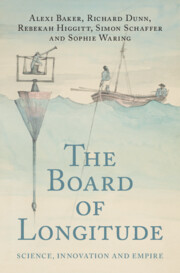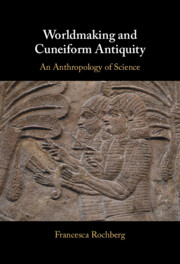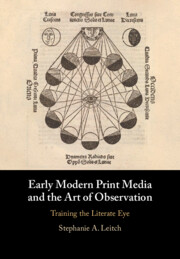Refine search
Actions for selected content:
137 results
TASSIE: a TASmanian Search for Inclined Exoplanets
-
- Journal:
- Publications of the Astronomical Society of Australia / Volume 42 / 2025
- Published online by Cambridge University Press:
- 09 June 2025, e083
-
- Article
-
- You have access
- Open access
- HTML
- Export citation
Becoming An Astronomer in Late Medieval China
-
- Journal:
- Journal of Chinese History , First View
- Published online by Cambridge University Press:
- 09 June 2025, pp. 1-20
-
- Article
-
- You have access
- Open access
- HTML
- Export citation
Chapter 6 - Astronomy
-
-
- Book:
- On Discovery
- Published online:
- 05 May 2025
- Print publication:
- 22 May 2025, pp 70-80
-
- Chapter
- Export citation
10 - What Is an Observatory? From the Metropolis to the Cape
-
-
- Book:
- The Board of Longitude
- Published online:
- 11 April 2025
- Print publication:
- 17 April 2025, pp 229-251
-
- Chapter
- Export citation
7 - Manufacturing the Nautical Almanac
-
-
- Book:
- The Board of Longitude
- Published online:
- 11 April 2025
- Print publication:
- 17 April 2025, pp 157-191
-
- Chapter
- Export citation
3 - Launching the Eighteenth-Century Search for Longitude
-
-
- Book:
- The Board of Longitude
- Published online:
- 11 April 2025
- Print publication:
- 17 April 2025, pp 39-64
-
- Chapter
- Export citation
5 - The Birth of the Board of Longitude
-
-
- Book:
- The Board of Longitude
- Published online:
- 11 April 2025
- Print publication:
- 17 April 2025, pp 89-121
-
- Chapter
- Export citation

The Board of Longitude
- Science, Innovation and Empire
-
- Published online:
- 11 April 2025
- Print publication:
- 17 April 2025
18 - Heavens: The Papacy, Astrology, and Astronomy to 1800
- from Part III - Science, Medicine, Technology
-
-
- Book:
- The Cambridge History of the Papacy
- Published online:
- 28 February 2025
- Print publication:
- 20 March 2025, pp 514-535
-
- Chapter
- Export citation
17 - Ottoman Science
- from Part II - Perspectives and Methods
-
-
- Book:
- The Cambridge Companion to Ottoman History
- Published online:
- 31 May 2025
- Print publication:
- 20 March 2025, pp 236-250
-
- Chapter
- Export citation
Discerning Patterns in Medieval Chinese Polymathy Through Bibliometrics: Astronomy, Mathematics, and their Historical Sister Sciences
-
- Journal:
- Journal of Chinese History , First View
- Published online by Cambridge University Press:
- 06 March 2025, pp. 1-26
-
- Article
-
- You have access
- Open access
- HTML
- Export citation
Chapter 7 - The Emergence of an Ars mensoria
- from Part IV
-
- Book:
- The <i>artes</i> and the Emergence of a Scientific Culture in the Early Roman Empire
- Published online:
- 22 March 2025
- Print publication:
- 13 February 2025, pp 316-371
-
- Chapter
- Export citation
2 - A Less Problematic Miracle: Greek Science
-
- Book:
- Why the Ancient Greeks Matter
- Published online:
- 06 February 2025
- Print publication:
- 06 February 2025, pp 25-84
-
- Chapter
- Export citation

Worldmaking and Cuneiform Antiquity
- An Anthropology of Science
-
- Published online:
- 09 January 2025
- Print publication:
- 09 January 2025
Sailing to Calanais: Monument Complexes and the Sea in the Neolithic of Western Scotland and Beyond
-
- Journal:
- Proceedings of the Prehistoric Society / Volume 90 / December 2024
- Published online by Cambridge University Press:
- 25 November 2024, pp. 253-277
- Print publication:
- December 2024
-
- Article
-
- You have access
- Open access
- HTML
- Export citation
12 - Menippus Goes to the Moon: Fantastical Astronomy and Lucian’s Scientific Imagination
- from Part II
-
-
- Book:
- The Cambridge Companion to Lucian
- Published online:
- 07 November 2024
- Print publication:
- 21 November 2024, pp 247-267
-
- Chapter
- Export citation
Callimachus, Conon and Ptolemy: an Alexandrian epigram between geography and astronomy
-
- Journal:
- The Journal of Hellenic Studies / Volume 144 / November 2024
- Published online by Cambridge University Press:
- 04 October 2024, pp. 198-208
- Print publication:
- November 2024
-
- Article
-
- You have access
- Open access
- HTML
- Export citation
16 - Hipparchos of Nikaia
- from Part III - Hellenistic Period
-
- Book:
- Geographers of the Ancient Greek World
- Published online:
- 25 March 2024
- Print publication:
- 18 April 2024, pp 441-465
-
- Chapter
- Export citation

Early Modern Print Media and the Art of Observation
- Training the Literate Eye
-
- Published online:
- 14 March 2024
- Print publication:
- 04 April 2024
10 - Scientific Communities and the Emergence of Science in Early Modern Japan
- from PART II - Economy, Environment, and Technology
-
-
- Book:
- The New Cambridge History of Japan
- Published online:
- 15 January 2024
- Print publication:
- 23 November 2023, pp 342-362
-
- Chapter
- Export citation








